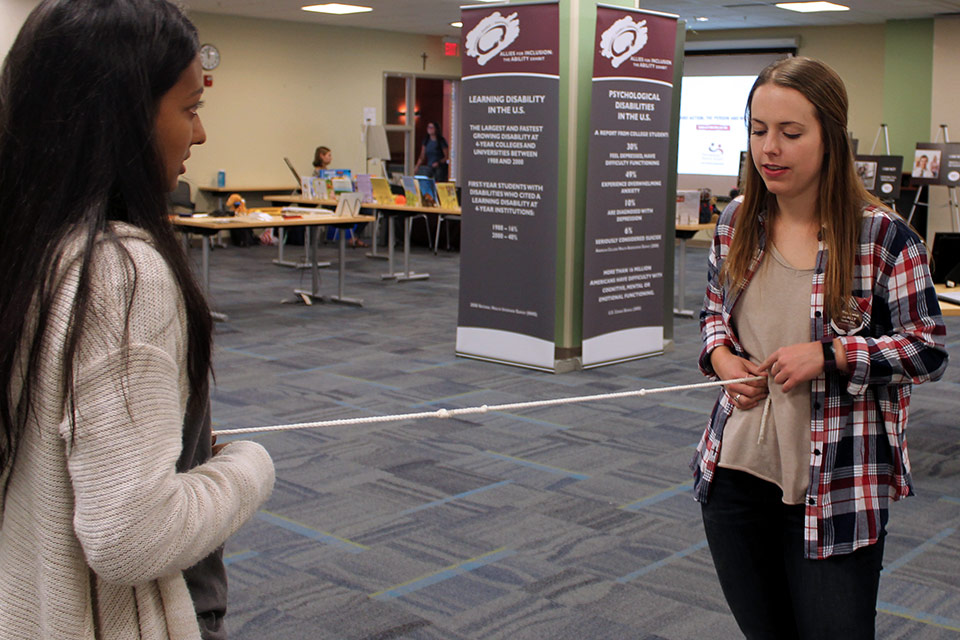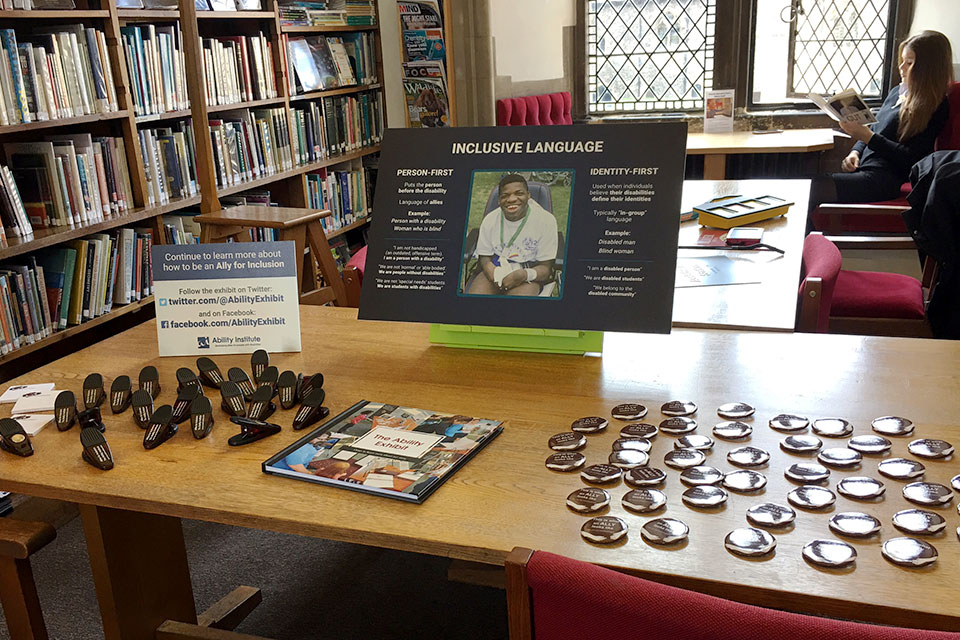Ability Institute Takes Its Message of Inclusivity Abroad
Ability activism has always been a part of life for Karen Myers, Ph.D., associate professor of leadership and higher education and director of Saint Louis University’s Ability Institute.
“Disability has been in my life all my life,” she said, referring to the legal blindness that she and 20 of her family members experience. Because the Americans with Disabilities Act has been in existence for more than 25 years, Myers assumed most people understand the basics of disabilities and empowerment. When she realized she was wrong, she went straight to work.
Together with Mary Ann Borgesen, graduate student in the School of Education and coordinator of business and operations, and Mark Pousson, Ph.D., faculty educator in the School of Education, Myers heads the Ability Institute, a three-program initiative created in SLU’s School of Education.
With the support of Dominique Masters, graduate student in the School of Education hailing from the United Kingdom, the Ability Institute left for London on Sept. 23. It was the institute’s first-ever international trip. The institute set up shop in three schools around England, spreading its message of inclusion and understanding far beyond what Myers anticipated when its original program, Allies for Inclusion: The Ability Exhibit, was created.
What started as a final project by a graduate student in Myers’s disability and higher education in society class in 2010 has since grown into an international program that promotes action for people with and without disabilities. Allies for Inclusion: The Ability Exhibit, travels to at least ten schools and corporations each year. A series of stations greets visitors, teaching them about person-first and identity-first language (identifying an individual as an individual instead of as a person with a disability), invisible disabilities and how to treat people with disabilities in the workplace. Interactive stations allow participants to see, feel, hear and act out what it means to have a disability.
The exhibit’s layout is intentional, put together in a way that is meant to ignite a passion and inspire a desire to act. Participants begin in Myers’s favorite exhibit, “Who do you know with a disability?”, where they place stones into jars marking types of disabilities their friends, family members or acquaintances may have – both mental and physical. With people in their lives who are affected by disability in mind, participants then journey through a series of stories and exercises that teach them empathy and encourage them to make life accessible for all people.
“It starts with, ‘what’s this all about?’ And by the end, it’s saying, ‘I am going to pledge to be an ally,’” Myers said. “That’s really the goal: global education for ally development and inclusion.”
Furthering the push to become an ally is the institute’s second program: the Ability Ally Initiative. This 90-minute workshop, developed by a student and supported through a United Way grant, has traveled throughout the country — as well as Ghana, Belize and Spain — to provide a quick, simplified experience of the lessons from the full exhibit when time and space are lacking.
The most recent addition to the Ability Institute hopes to ignite the ally mindset early. Ability Allies in Action: The K-5 Curriculum is a program coordinated by Diane Richter, a doctoral student in disability education at SLU. Building on the progress first made by Maureen Wikete Lee, Ph.D., associate dean of the School of Education, Richter works to create a curriculum for teachers that fits into a suitcase and aligns with Missouri’s learning standards.
Recognizing that teachers are short on time, Richter created an easy and fun program of activities for each grade that teaches inclusion within the bounds of other topics teachers already plan to cover. One assignment uses students’ engineering skills to encourage them to investigate their own playground. Students in the fourth grade learn about accessible playgrounds and design an ideal playground based on the accessibility standards they learn. Richter sees these assignments as the starting point through which teachers can empower students, schools and their community to become aware of abilities and inclusion.
“It’s not just one day or week dedicated to disability awareness, but it’s integrated into the school and the community,” Richter said.
Helping communities ignite and improve their ally mindset has been the crowning achievement of the Ability Institute. Myers is proud that in seven years, the exhibit has appeared more than 100 times at universities, community organizations and corporations.
She is grateful for monetary and spiritual support from SLU alumna and long-time volunteer Mary Bruemmer, as well as the incredible positive response she’s received from the School of Education, Student Development and Logan College of Chiropractic. Richter sees the institute best advertised through students who are preparing to become teachers; she has witnessed them beginning to see things through the eyes of accessibility and inclusion, and she is excited to know that they will create their classrooms with these ideas in mind.
School of Education graduate student Tanyathorn Hauwadhanasu is one such student. The parent of a child with autism, Hauwadhanasu already recognized the importance of advocating for people with disabilities. Myers’s class gave Hauwadhanasu the tools to speak out for those with visible and invisible disabilities - something she sees as in line with SLU’s overall mission.
The exhibit has “built knowledge and promoted inclusion and social justice. SLU’s mission is inclusion, social justice and diversity,” said Hauwadhanasu, who sees disability as a kind of diversity. “People can become aware of that and treat each other with respect and acceptance. That’s the exhibit’s impact.”
Farah Habli, doctoral student in the School of Education, agrees.
“It was a very rich exhibit,” she said of the first time she experienced it. “I learned all I needed to know in one visit.” She sees the exhibit as a “place where every person can know about inclusion and how to advocate for it.
Myers finds the most value in the small changes made by people who go through the exhibit. It’s why she is so proud of the final stop on the exhibit’s journey, which asks participants how they will be an ally for inclusion.
“What’s very exciting to me, in class and in the exhibit, is when people say, ‘wow, I never knew that. I’m going to go home and make my font on my email universally designed, or change our website, or lower a bookshelf so people in a wheelchair can reach our pamphlets.”
These commitments – whether large or small – make all the difference to Myers, who hopes participants-turned-allies will begin to change how we see ability and disability at Saint Louis University and beyond.
Last week’s London and Canterbury trip was the first time all three institute programs went abroad together. Their travels included stops at Saint Mary’s University, Kent University and The King’s School.
Myers and her team brought a brand-new version of the exhibit to the U.K., made specifically for global travel and international outlook.
“The United Kingdom has disability laws, and they are very attentive,” she said. “However, it is an older country, so some of the facilities may not be as accessible.” She hopes this will be the first of many trips to the United Kingdom and beyond.
Moving forward, Myers and Richter hope to continue helping others see ability and inclusion wherever they go. “My hope is that the program becomes global and that everyone will be on board,” she said. She said she hopes that all people throughout the world will one day consider themselves allies.
When thinking about what it means to be an ally, Myers recalls one third grader’s response to that question when the institute visited his school.
“He raised his hand and said, ‘It’s being a friend.’ And I couldn’t say it any better,” she said.



















